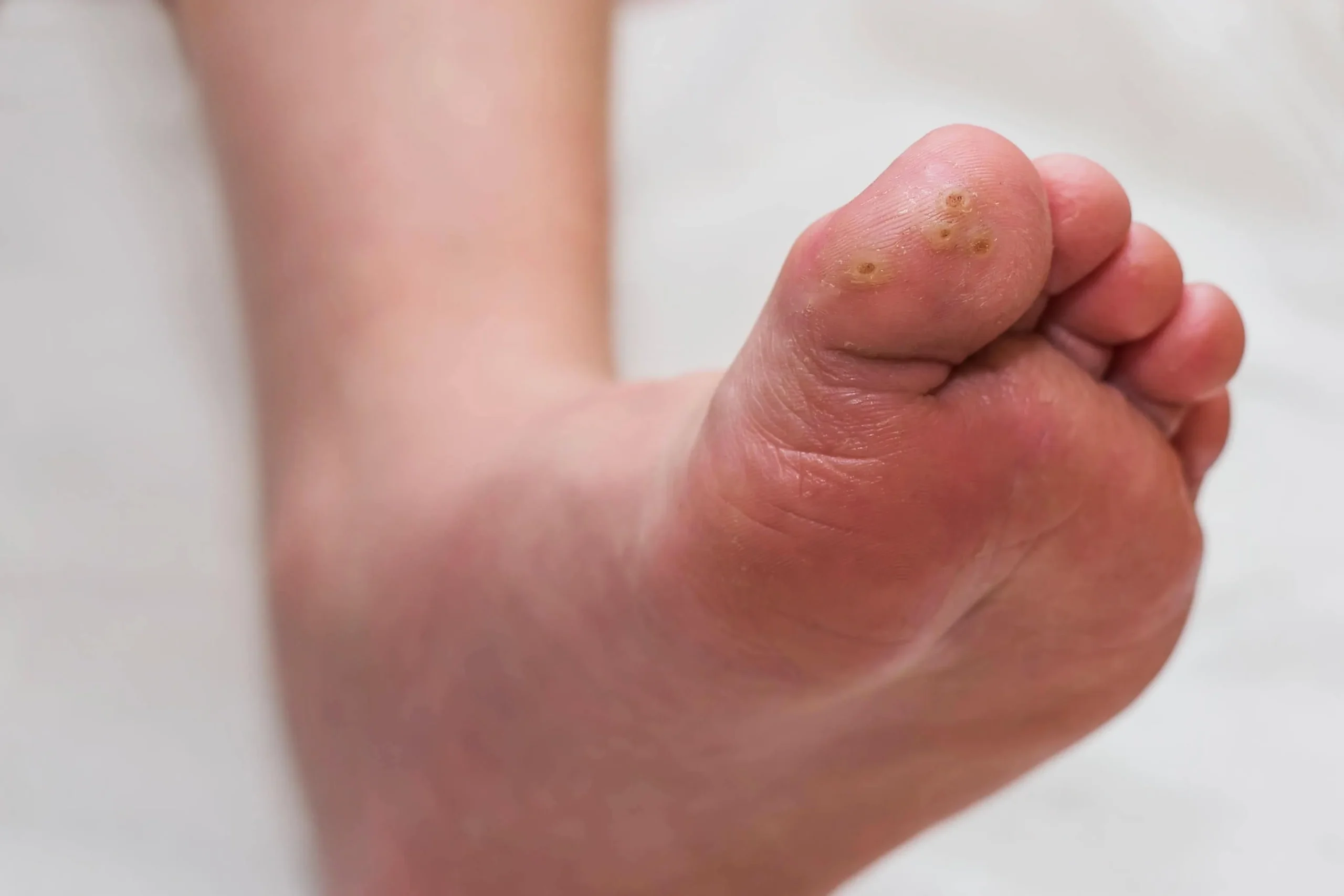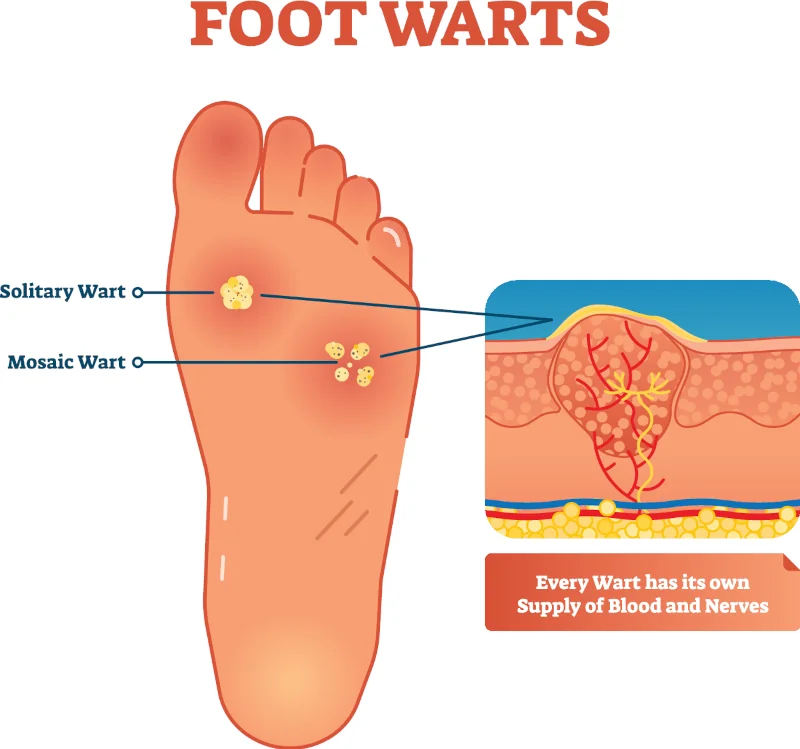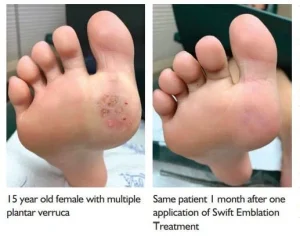
Plantar warts are small, rough growths that appear on the soles of the feet, caused by an infection from the human papillomavirus (HPV). This is a type of virus that can also cause genital warts, and it can be spread. The virus enters through tiny cuts or breaks in the skin. We’ll also take a closer look at how plantar warts develop. By understanding how they develop, you can take steps to reduce your risk and prevent their spread.
What is the cause of plantar warts?
The causes of plantar warts are simply that your body’s immune system is not fighting the wart virus. Yes, warts are contagious but why do some people get them more than others? This can be from an immune system not strong enough to fight the virus.
- Weakened Immune System: Individuals with weakened immune systems are more susceptible to developing plantar warts which may correlate with alterations in hormone levels.
- Hormones: Examples of how hormones may play a role include the tendency for warts to appear more frequently during puberty and a possible association with birth control pills.
- Direct Contact: Touching a wart or sharing personal items like towels or shoes with someone who has warts can lead to transmission.
- Moist Environments: HPV thrives in warm, moist environments, making feet particularly vulnerable.
- Walking Barefoot: Walking barefoot in public areas like locker rooms, swimming pools, or communal showers increases the risk of contracting HPV.
Presentation of warts on your feet
Warts can occur anywhere in the body, but the most common part of the body where they appear is on the feet typically on the bottom of the foot or in the toes. They appear harder than normal skin and can cause pain when pressure is applied to them, especially when squeezed. They oftentimes will have dark specks on them and when trimming a wart, there can be small areas of pinpoint bleeding because there are tiny blood vessels within the wart tissue. A wart can present in a single area and the size can vary greatly. The most difficult presentation of a wart is called a mosaic wart. This type of wart consists of multiple small warts over a large area.

Treatments for plantar warts
Home Remedies
The following are home remedies that you may want to try.
- Salicylic Acid – There are over-the-counter products with salicylic acid, commonly used for treating warts caused by HPV, which is also one of the causes of plantar warts. These products are applied daily and slowly eat away the wart. If the warts are multiple or large, this process may take a while, as over-the-counter salicylic acid is not a prescription strength.
- Apple Cider Vinegar – Apple cider vinegar is thought to be acidic and can help destroy the wart tissue. The suggested method is applying apple cider vinegar to a cotton ball and taping it to the wart overnight.
- Pumice Stones – Often used alongside salicylic acid, a pumice stone can be rubbed on the wart to remove dead wart tissue.
- Duct Tape – Some find that applying duct tape to the wart daily helps to break down the wart tissue.
Conventional Treatments your Podiatrist may recommend
- Salicylic Acid (Prescription Strength) – Salicylic acid with a higher concentration or percentage than over-the-counter products may be applied to the foot and reapplied every two weeks. The patient returns to the office and the dead wart tissue will be trimmed away. Salicylic acid will then be reapplied until the wart is gone. The number of treatments can greatly vary.
- Cantharone – Cantharone treatment is similar to salicylic acid. However, Catharone creates an allergic reaction (blister) which is destructive to the wart and the treatments are every two weeks until full destruction of the warts has taken place.
- Surgical Excision – When surgery is performed, it is usually in a clinical setting and you can walk immediately. Anesthesia is used to numb the area.
- Laser Treatments – Various forms of laser may be used to destroy wart tissue.
- Bleomycin Injections – This can be done into the wart tissue as bleomycin injections are thought to be destructive to the wart.
- Liquid Nitrogen – Liquid nitrogen can be used to freeze the wart, and it is used a lot by primary care doctors and dermatologists as it is used throughout the body, but it is not favored by most foot specialists as we believe it is not as effective on warts of the foot. The reason for this is that most warts on the foot are on weight-bearing areas of the skin and the body’s weight pushes those warts deeper into the skin where the liquid nitrogen may not penetrate.
The Fallacy of Wart Treatments
All home remedies and conventional treatments by doctors have one thing in common: they are all destructive in nature. The goal is to destroy the wart by different means, but the underlying causes of plantar warts have never been fully addressed until now. Continue reading to understand how the SWIFT device targets the root cause of the problem, helping to reduce the recurrence rate.
The SWIFT device as a treatment for Plantar Warts is a game changer! It can strengthen the immune system to get rid of the wart and once treatment is completed, the patient is less likely ever to have wart recurrence.
Introducing the SWIFT device for the treatment of plantar warts
The SWIFT device was introduced as a medical device approximately 3 years ago and it is the only known treatment that is able to treat the cause of the wart.

How does the SWIFT device work for plantar warts on your feet?
The SWIFT device produces microwave heat energy and delivers microwave heat into the tissue. The treatment involves five two-second applications of this energy. There are no side effects afterward and no discomfort after treatment. This microwave heat has an effect on heat shock proteins within the viral tissue. The heat shock proteins are released during the treatments which alert the immune system of the HPV virus. By altering these heat shock proteins, the body’s immune system recognizes the virus and attacks the wart tissue. A minimum of three treatments are needed spaced at one-month intervals.
The SWIFT device has been our treatment of choice for plantar warts as it provides a safe and effective option. It does not require the patient to have destructive, painful treatments that may require dressings or keeping the foot dry during treatment. It is also the smartest way to treat warts as we’re not managing the condition but rather using a technology that addresses the root cause. So, if you have been struggling with wart treatments, please consider this new technology as the preferred option. With two convenient foot and ankle clinical locations in Fort Collins and Broomfield, Colorado, our experienced doctors will talk you through the procedure and what to expect. Check our YouTube video on plantar warts here.
Call us today at our Fort Collins location (970) 329-8158, Broomfield location (303) 997-2795, Surgery Center (970) 329-8158, or use our online scheduling system to book your appointment.
Frequently Asked Questions About the Causes of Plantar Warts
- What causes plantar warts to develop?
Plantar warts are caused by the human papillomavirus (HPV), which infects the outer layer of skin on the soles of your feet. - How does HPV enter the skin to cause plantar warts?
The virus enters the skin through tiny cuts, abrasions, or cracks on the surface of the feet, often in moist environments like locker rooms or swimming pools. - Is HPV contagious, and can it spread to others?
Yes, HPV is contagious and can spread through direct contact with an infected person or surface, such as shared showers or towels. - Why do some people get plantar warts while others don’t?
Susceptibility depends on individual factors like immune system strength, skin integrity, and frequent exposure to high-risk environments. - Can wearing certain types of footwear contribute to plantar warts?
Yes, wearing shoes that trap moisture or walking barefoot in public places increases the risk of contracting the HPV virus and developing plantar warts.


